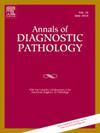Application of an in situ hybridization method for fungal diagnosis in formalin-fixed, paraffin-embedded allergic fungal rhinosinusitis tissue
IF 1.4
4区 医学
Q3 PATHOLOGY
引用次数: 0
Abstract
Allergic fungal rhinosinusitis (AFRS) is a chronic inflammatory disease of the sinuses that can involve serious late complications; thus, prompt diagnosis is essential to determine the appropriate treatment. The most important diagnostic element of AFRS is the detection of noninvasive fungi within eosinophilic mucin. However, the rarity of fungal hyphae in ARFS makes it difficult to specifically identify them using histochemical staining alone. In this study, we designed a new in situ fungal detection probe for the diagnosis of fungi in formalin-fixed, paraffin-embedded AFRS tissues. Tissue sections from 49 patients with confirmed (n = 40) or suspected (n = 9) AFRS were selected for testing. A newly designed broad-spectrum probe for in situ hybridization (ISH) was compared with an anti-Aspergillus antibody in immunohistochemistry (IHC) and staining with hematoxylin and eosin and periodic acid-Schiff (PAS) to detect fungi. Hematoxylin and eosin staining had a lower detection rate (30/40 samples) than the other three methods. PAS staining led to two false-positive results in the AFRS-confirmed group and two false-negative results in the AFRS-suspected group. ISH and IHC exhibited high concordance (ĸ = 0.716); however, there was a high degree of nonspecific immunoreactivity to the anti-Aspergillus polyclonal antibody in some samples. The fungal detection rate of ISH was 95 % (38/40), with no background or nonspecific reactivity. Our novel broad-spectrum ISH probe provides more specific identification of fungi than PAS and IHC staining, exhibits no background reactivity, and may represent an essential upgrade to the in situ diagnosis of AFRS.
原位杂交法在福尔马林固定石蜡包埋变应性真菌性鼻窦炎组织真菌诊断中的应用
过敏性真菌性鼻窦炎(AFRS)是一种慢性鼻窦炎症性疾病,可涉及严重的晚期并发症;因此,及时诊断对于确定适当的治疗方法至关重要。AFRS最重要的诊断要素是检测嗜酸性粘蛋白内的非侵入性真菌。然而,真菌菌丝在ARFS中的罕见性使得仅用组织化学染色难以特异性鉴定它们。在这项研究中,我们设计了一种新的原位真菌检测探针,用于诊断福尔马林固定石蜡包埋的AFRS组织中的真菌。选取49例确诊(n = 40)或疑似(n = 9) AFRS患者的组织切片进行检测。将新设计的广谱原位杂交探针(ISH)与免疫组化(IHC)抗曲霉抗体进行比较,并用苏木精和伊红染色及周期性酸-希夫(PAS)染色检测真菌。苏木精和伊红染色的检出率(30/40)低于其他3种方法。PAS染色导致afrs确诊组出现2次假阳性结果,疑似afrs组出现2次假阴性结果。ISH与IHC具有较高的一致性( = 0.716);然而,部分样品对抗曲霉多克隆抗体有高度的非特异性免疫反应性。ISH真菌检出率为95%(38/40),无背景或非特异性反应性。我们的新型广谱ISH探针比PAS和免疫组化染色提供了更具体的真菌鉴定,没有背景反应性,可能代表AFRS原位诊断的重要升级。
本文章由计算机程序翻译,如有差异,请以英文原文为准。
求助全文
约1分钟内获得全文
求助全文
来源期刊
CiteScore
3.90
自引率
5.00%
发文量
149
审稿时长
26 days
期刊介绍:
A peer-reviewed journal devoted to the publication of articles dealing with traditional morphologic studies using standard diagnostic techniques and stressing clinicopathological correlations and scientific observation of relevance to the daily practice of pathology. Special features include pathologic-radiologic correlations and pathologic-cytologic correlations.

 求助内容:
求助内容: 应助结果提醒方式:
应助结果提醒方式:


